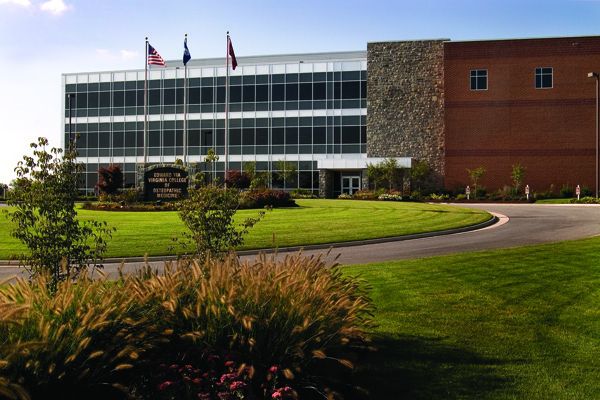The Edward Via College of Osteopathic Medicine (VCOM) – Virginia campus is located at the Virginia Tech Corporate Research Center in Blacksburg, Virginia. The campus operates within a public/private collaboration with Virginia Tech, sharing resources for the purposes of education, research, and student activities.
The main campus building in Blacksburg, Virginia, is approximately 60,000 square feet and is located on a 13-acre campus. There are two parking areas: a student area and a faculty/staff area with ample parking for everyone. VCOM-Virginia’s information systems, provided through Virginia Tech, provide their campus community with access to information systems and resources worldwide. The classroom environment affords optimum learning with two theatre classrooms and 10 moderately sized rooms for small-group learning. Clinical skills laboratories are interconnected using modern video, computer technology, and net meeting technologies.

In a separate facility, VCOM-Virginia also has 21,000 square feet of research laboratory space that houses seven biomedical research laboratories. All VCOM-Virginia students have access to Virginia Tech campus and activities including sports and intramurals.
The Simulation and Technology Center – In June 2008, VCOM opened a 21,000 square foot Simulation and Technology Center. The Center houses cutting-edge high-fidelity human medical simulators, standardized patient examination rooms, simulated surgical and intensive care unit suites, physical diagnosis and osteopathic manual therapy training labs, a simulated anatomy lab and radiology suite, and room for additional medical education programs. This facility represents the latest in medical simulation and learning technology. The Center contains six large rooms that house the clinical skills labs for physical diagnosis as well as osteopathic manual therapy.
VCOM Institute for Biomechanical and Sports Medicine Research – VCOM II houses the VCOM Institute for Biomechanical and Sports Medicine Research. This building has cutting-edge biomechanical research programs and accommodates a sophisticated deceleration sled that is used for the study of impact injury biomechanics and the prevention of such injuries. The building also contains an 11,000 square foot facility for the Graduate Certificate Premedical Program.
Library – The library is located on the second floor of the main campus building. It is a state-of-the-art electronic medical resource center serving the faculty, staff, and students of the College. Medical students also have access on campus to the Virginia Tech Libraries which includes the main library, Carol M. Newman Library, and the Veterinary Medicine Library.
→ You may request a tour online.
→ Check out upcoming events.
→ Learn more.
Mission
The mission of VCOM is to prepare globally-minded, community-focused physicians to meet the needs of rural and medically underserved populations and promote research to improve human health.
Strategic Goals
1. To provide education in the art and science of osteopathic medicine.
- To provide osteopathic medical education and research focused on evidence-based medicine, patient-centered care, the body’s innate ability to heal, the relationship of structure to function, and the clinical application of osteopathic manipulation.
- To prepare students and measure their performance in the osteopathic medical competencies.
- To prepare students to successfully pass all levels of COMLEX USA examinations.
- To prepare students to successfully match into accredited residency programs.
- To foster a culture of faculty growth and institutional excellence through:
- CME and faculty development;
- Continuous examination, review, and update of curriculum and recognition for excellence in teaching;
- Annual review and research on new developments in medical education, new delivery models, and technology; and
- Support for faculty research, innovation, and scholarly work in the areas of biomedical, clinical, educational, public health, and health policy research.
- To support the osteopathic medical education continuum, including on-campus preclinical education and high-quality, structured community-based clinical graduate medical education.
2. To recruit and graduate students who will address health care disparities including those related to rural locations, minority populations, poverty status, and primary care.
- Recruit students from, and educate students in the socioeconomically depressed regions of Virginia, North Carolina, South Carolina, and Alabama, especially those in Appalachia and the tobacco and cotton regions of the Southern States.
- Recruit students with a strong desire to care for medically underserved populations.
- To foster medical students with a desire and demonstrated commitment to an enhanced understanding of global healthcare and disaster medicine.
- To foster primary care and healthcare for medically underserved populations.
3. To generate, promote, and disseminate medical knowledge in disease prevention, chronic disease management, community health, and public health practices through Appalachian and International outreach programs.
4. To advance scientific knowledge through medical research.
- Biomedical Research
- Clinical Research
- Educational Research/Osteopathic Principles and Practice
5. To serve as an advocate of osteopathic medicine, rural health, mission medicine, and affordable, accessible healthcare for the medically underserved.
- To promote primary care practices.
- To promote osteopathic distinctive practices.
- To develop a diverse workforce of physicians who will practice in underserved areas.
- To provide outreach to rural communities and the uninsured.
- To promote mission medicine.